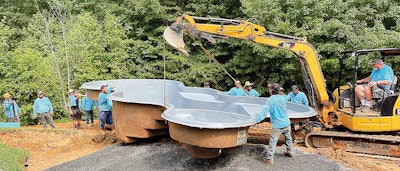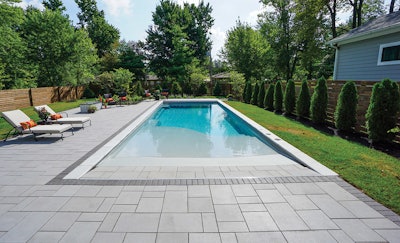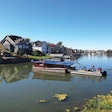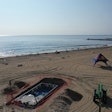
The great thing about fiberglass pool building is its relatively standardized process which can be improved and honed. Each time you cut out a potential problem area or waste or delay, you save a little more money on your cost.
The most profitable fiberglass builders are always looking at their process for ways to squeeze out unnecessary expenses and shrink down risk. And one area that offers opportunity to do that is the handling of shells: that is, the receiving of a fiberglass shell off a trailer at the jobsite, and the lifting and lowering of it into a waiting hole.
There’s more to it than one might think, because at the jobsite, the conditions on the ground and in the air are unpredictable, and it’s over that ground (which may be blocked, rutted, or flat-out moated) and through that air (which can be full of wind and rain) that the shell must travel as it moves from the manufacturer’s trailer to its final resting place in the newly hollowed ground.
There are three principal means of doing it. You can use a crane, an excavator or a telehandler (a machine that goes by lots of names, including “telescoping forklift,” “reach forklift” and often by the name of one of its manufacturers, “Lull”).
Each of these machines uses hydraulics to lift the heavy, cumbersome shell into the air, which is a different exercise than say, lifting a pallet of limestone pavers, because while a shell can be several thousand pounds, it’s shaped more or less like a sail and thus can easily catch the wind. Also, it’s floppy and chippy at the edges, adding to the challenge. Breaking the shell will demoralize the crew.
The most important part is the mechanism in touch with the ground, what is used to carry the shell from the flatbed/trailer in the road to the backyard hole — typically wheels for telehandlers and tracks for excavators. The crane just sits in one spot and swings.
The three types of shell-moving equipment are just different tools. It’s up to the imagination and creativity of the builder to judge the unique situation every home presents, and apply the best tool for the job in the most efficient, cost effective and safe manner. It's part of the fun of pool building.
 In this photo, a San Juan Desert Springs 14-by-30-foot pool/spa combo is making its way toward its final resting place, guided by the crew from Poolscapes of Charlotte.Photo courtesy Poolscapes of Charlotte
In this photo, a San Juan Desert Springs 14-by-30-foot pool/spa combo is making its way toward its final resting place, guided by the crew from Poolscapes of Charlotte.Photo courtesy Poolscapes of Charlotte
SAFETY FIRST
Cranes are very popular for moving shells into place because of their undeniable advantages, starting with safety.
“It’s a little safer because it’s a stationary piece of equipment,” says Builder Carlton Rivers, “as opposed to a Lull or excavator. Once you set it up, you can move the pool slowly into place just using the crane and the boom and the hydraulics and cabling.”
Rivers was a pool builder for 30 years, working in gunite, vinyl and fiberglass. A few years ago, he sold his business and became a trainer for Explore Industries. He’s based in Carrollton, Ga., just southwest of Atlanta.
Generally speaking, when Rivers was building his own pools, he’d look for the smallest crane that could do the job, as the bigger the crane, the more expensive it is to rent. “We’ve seen prices anywhere from $500 for a smaller crane for a three-hour minimum to as much as $4, $5,000 for a large one that has to reach a long way. And that has to be carefully considered on the front end when you’re pricing the pool, unless you want to lose a lot of money, which I hate to do.”
That reach (and thus the size of the crane) you need on the job is often determined by the home’s geography. The crane’s set-up point becomes the center of a circle whose radius is the reach distance of the crane. The shell’s trailer and its intended hole must fit inside that circle. Ideally, you can set up the crane in a spot halfway between the pool trailer and the hole, perhaps in the front yard or side yard, and just swing the shell over.
There are plenty of times when the geography of the home and the geometry of cranes are at odds. “Sometimes, the hole is too far away from the street where you have the trailer,” Rivers says. “Sometimes the only place to set up the crane is in the street, right beside the trailer with the pool. Well, now you’ve got to reach 150 feet to the backyard. That’s going to take a larger crane, and that means more money.”
“As a builder, we rented a lot of cranes, but we also used a Lull a lot on pools in rural areas with long narrow driveways, which is often a problem for the crane. In those cases, we’d have to pick it up on the road and tote it down the driveway and around back with the Lull.”
 This tilted pool orientation keeps the overall width of the trailer under 12 feet and allows shipping without expensive escort vehicles. It also provides welcome shelter from the occasional downpour.Photo courtesy Poolscapes of Charlotte
This tilted pool orientation keeps the overall width of the trailer under 12 feet and allows shipping without expensive escort vehicles. It also provides welcome shelter from the occasional downpour.Photo courtesy Poolscapes of Charlotte
IT'LL BE OVER BEFORE YOU KNOW IT
Anytime you’re lifting a pool, one or two guide ropes are left dangling so that people on the ground can hold onto it and keep it from swinging or spinning and help maneuver as it moves along. Taking it through the side yard is preferable to the more spectacular but risky flight path over the roof.
“The crane companies and the pool dealers certainly want to avoid taking that pool over the house. But if they have to go over the top, then of course you have to just let the guide rope go and grab it on the other side,” Rivers says.
“I played a joke on a guy one time. We were about to crane a pool over a house, and he was holding the guide rope. He wasn’t on our crew and didn’t know anything about what we were about to do. And I told him, ‘You know, when we go over the house, just hang on tight for a little while, and you’ll be over the house before you know it.’
“His eyes got big. [laughs] I was just messing with him, of course.”
SCHEDULING AND TEAMWORK
Pool building is all about teams and scheduling and sequence, so flexibility in a component of that process is valuable. One downside to cranes is that they tend to be on a tighter schedule: They’re usually booked for a time and date, and once things are set up, the clock is ticking. On the other hand, a telehandler or excavator, whether it’s rented or owned, will have a more forgiving schedule.
“Some dealers are hiring excavation crews to dig and prep the hole, they’re not doing it in-house. So if something goes wrong with your crane rental, now you’ve got another sub or two that need to be rescheduled. That can be a little bit aggravating,” Rivers says.
“Most of the dealers I see are actually renting Lulls. The rental company will drop it off for 24 hours. So if you run into a problem, you still have some more time that day and even the next day to drop the pool in, whereas when a crane sets up, you’re going to pay that minimum fee. And if they have to come back the next day, you have to pay them again.”
 Equipment access and egress in tight backyards like this always calls for careful planning. Shown here is a beach entry pool from Thursday Pools.Photo courtesy Thursday Pools
Equipment access and egress in tight backyards like this always calls for careful planning. Shown here is a beach entry pool from Thursday Pools.Photo courtesy Thursday Pools
TELEHANDLERS AND EXCAVATORS
The reason why telehandlers aren’t as safe as cranes is because when a telehandler has a 3,500-pound load raised 15 feet up on the forks, and it hits a bump or a hole, that produces a lot of torque at the base. If conditions are just right, perhaps it’s already headed downhill or there’s a following wind, the thing can tip over.
“That’s why we prefer cranes when we can use them,” Rivers says, “because you avoid those issues. Let’s say you dug up a stump that’s in the path to the pool and of course, you’ve filled up the hole, but it’s still soft. And now the Lull is coming along. And as one tire on the machine goes over the hole, it sinks down in that hole very quickly, and it can cause an instant tip.
“I saw a pool cracked that way. A guy with a pool up on the forks was trying to go across some mud to get the pool in the hole when he should have waited. But he went anyway, going kind of fast to try to get it across quickly, and the wheel dropped into a little bit of a hole, and the pool kind of jolted. And I heard it crack, and said, ‘Well, looks like we got a problem.’ [laughs]
“Another common situation that can turn into a problem is if you’re going downhill and the pool’s out in front and you hit a bump, the weight up on the boom can take that machine right on over. So we always recommend you back down that hill with the pool on the uphill side. But sometimes there’s yards where there’s no room to turn around when you get down there. Each site is different.”
In general, the telehandler’s relatively thin, hard rubber tires — great for hard surfaces like roads and driveways — are not really ideal if the homeowner has done some grading in the yard recently, or it’s rained for the past three days.
Under those conditions, a typical 8,000-pound capacity, 27,000-pound-gross-weight telehandler on skinny tires will sink down as if into a spa after a hard day’s work.
“I’ve seen that happen numerous times,” says Rivers. “And I’ve gotten stuck myself, too. That’s one reason dealers like excavators for toting pools, because they do a much better job bridging across potholes and mud. So you might not have to cancel out that day where it’s too muddy for the Lull, because that excavator will walk right through that mud.”
Another reason for the choice of an excavator to carry the pool is they’re often already onsite digging the hole, so you don’t have to monkey with transporting anything else to the jobsite.
GOOD ADVERTISING
In any pool project that’s trying to keep to a schedule, there’s pressure to get the job done. You’re trying to meet a schedule, but then something unexpected happens, and suddenly, you’re deciding whether to postpone the job — knowing that with the supply chain in turmoil, you may not get another chance at a shell for a while.
“Right now, in this crazy market, canceling a pool is a disaster,” Rivers says. “Companies are struggling to get them to the right homeowner in a timely fashion. So if something comes up where you can’t move the shell to the backyard, I would unload the pool and set it right there in the front yard until you can place it in the hole.”
There are always a lot of judgment calls when setting in a shell, Rivers admits, and sometimes discretion is the better part of valor. “I was with a dealer trying to put in a pool after a big rain, and it was just too muddy. The pool wasn’t there yet, and they did a test run with just the Lull, no pool on it, and it was still sinking in. And I said, ‘Guys, I just wouldn’t do this. I know I’m here to help train you, it’s not my decision, but this is just too risky.’ And they agreed. And so when the pool arrived, they just set it in the front yard. It’s good advertising, right?”
This article first appeared in the July 2022 issue of AQUA Magazine — the top resource for retailers, builders and service pros in the pool and spa industry. Subscriptions to the print magazine are free to all industry professionals. Click here to subscribe.










































